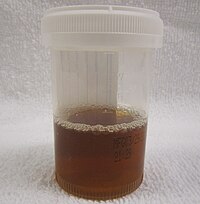
Photo from wikipedia
Objective Investigations on coagulation parameters including fibrinogen (Fbg), fibrinogen degradation products (FDP), and D-dimer in ischemic stroke patients treated with intravenous thrombolysis are insufficient. We aimed to investigate the association… Click to show full abstract
Objective Investigations on coagulation parameters including fibrinogen (Fbg), fibrinogen degradation products (FDP), and D-dimer in ischemic stroke patients treated with intravenous thrombolysis are insufficient. We aimed to investigate the association between in-hospital clinical outcomes and the coagulation parameters at different time points in ischemic stroke patients treated with intravenous tissues plasminogen activator (IV tPA). Methods We retrospectively enrolled patients who received IV tPA therapy within 4.5 h from symptoms onset. Demographics, clinical characteristics, imaging measures, and the discharge mRS score were collected. Multivariable logistic regression analyses were performed to test whether coagulation parameters were independent predictors for the in-hospital clinical outcomes. We also employed machine learning models to investigate whether coagulation parameters were able to improve the prediction of favorable functional outcomes. Results One hundred and fifty-two patients treated with IV tPA were included. Among the coagulation parameters, low D-dimers at 48 h proved to be an independent predictor of favorable functional outcome (adjusted odd ratio 0.24, 95% confidential intervals 0.06-0.92, P = 0.04). The AUC of D-dimer at 48 h to predict favorable functional outcome was 0.73 (0.60-0.87) and the optimal cut-off value was 0.92 (sensitivity 0.69, specificity 0.78). Machine learning models with D-dimer at 48 h had superior performance in predicting favorable functional outcomes and among the input variables in the machine learning models, D-dimer at 48 h showed the highest weight in predicting mRS 0-1 at discharge (38.44%). Conclusion Increased levels of D-dimer at 48 h was associated with lower proportion of favorable functional outcomes in acute ischemic stroke patients with intravenous thrombolysis.
Journal Title: Clinical and Applied Thrombosis/Hemostasis
Year Published: 2022
Link to full text (if available)
Share on Social Media: Sign Up to like & get
recommendations!